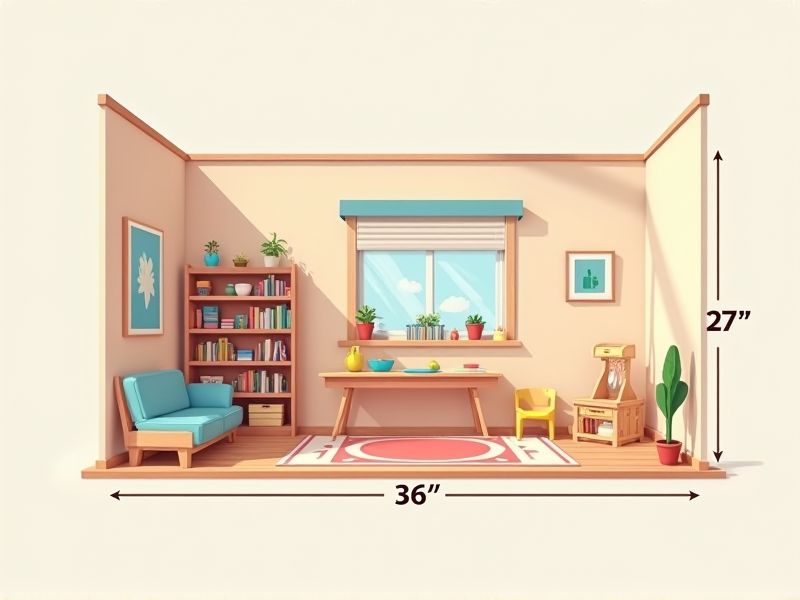
When planning a playroom, it's important to consider both available space and your child's needs. A standard playroom is typically around 10 by 10 feet (3 by 3 meters), which comfortably accommodates basic play furniture and storage. If you have more space, a 12 by 12 feet (3.6 by 3.6 meters) room allows for activity zones or larger play structures. Ultimately, the dimensions should allow safe movement, easy supervision, and sufficient storage for toys and supplies.
Space For Movement
A well-designed playroom prioritizes space for movement, ensuring that children have ample room to explore and engage in physical activities. Ideally, the play area should span at least 100 square feet to accommodate various play equipment and free movement. This openness not only promotes physical development but also enhances social interactions among children. Incorporating soft flooring and flexible layouts can further enhance safety and creativity in this essential play environment.
Safety Features
A standard playroom emphasizes safety features to create a secure environment for children, incorporating soft flooring materials like foam mats or carpet to reduce the risk of injury from falls. Safety gates can be installed at doorways to prevent unsupervised access to hazardous areas, while furniture should be anchored to walls to prevent tipping. Non-toxic, child-friendly decor and toys are essential, ensuring that all items meet safety regulations and avoiding potential choking hazards. Regular safety inspections are vital, with a focus on checking for loose parts and ensuring that all play equipment is in good working condition.
Natural Lighting
Natural lighting in playrooms significantly enhances the atmosphere and overall well-being of children. Studies show that exposure to natural light can improve mood and increase focus by up to 20%. Incorporating large windows or skylights allows sunlight to flood the space, creating a vibrant environment that encourages creativity. When designing your playroom, aim for at least 25% of the wall area to be dedicated to windows to maximize daylight exposure.
Ventilation
Effective ventilation in a playroom is crucial for maintaining a healthy environment for children. Ideally, a playroom should have an air exchange rate of at least 15 cubic feet per minute (CFM) per person to ensure fresh air circulation. Incorporating energy-efficient windows and exhaust fans can significantly reduce indoor air pollutants and enhance comfort. Regular maintenance of ventilation systems is essential to uphold air quality and prevent issues like mold growth and excessive humidity.
Storage Solutions
An efficient playroom should prioritize innovative storage solutions to maximize space and organization. Utilizing vertical storage options, such as wall-mounted shelves and bins, can significantly enhance the room's capacity, freeing up floor space for play activities. Incorporating multi-functional furniture, like storage ottomans or benches, allows you to neatly tuck away toys and games while providing extra seating. For optimal accessibility, ensure that bins are labeled with pictures or words, making it easier for children to identify and return their toys independently.
Child-Friendly Furniture
Child-friendly furniture in playrooms ensures safety and comfort, allowing children to explore their creativity without risks. Typically, this furniture includes rounded edges, non-toxic materials, and adjustable heights to accommodate growing children, making it an essential aspect of any play environment. The use of vibrant colors and engaging designs helps stimulate a child's imagination while promoting a warm, inviting atmosphere. Investing in quality, durable items can result in less frequent replacements, ultimately saving you money in the long run.
Interactive Play Zones
A high-quality playroom design emphasizes interactive play zones that stimulate children's creativity and social skills. These zones typically include features like climbing structures, sensory tables, and role-playing areas, promoting physical activity and imaginative play. Research indicates that children engage more meaningfully in environments where they can explore and interact with a variety of materials, helping them develop critical thinking and problem-solving skills. Investing in diverse interactive elements can significantly enhance the overall play experience, making it both educational and enjoyable for your children.
Color Schemes
A thoughtfully designed playroom can significantly enhance a child's creativity and mood by incorporating effective color schemes. The use of vibrant primary colors--such as red, blue, and yellow--can promote energy and enthusiasm, while softer pastel shades like lavender or mint green foster a calming atmosphere conducive to play and relaxation. Research indicates that color can impact children's behavior, with brighter tones often stimulating activity levels and darker hues providing a sense of security. Consider implementing a cohesive color palette that integrates furniture, decor, and toys, ensuring an engaging and visually appealing environment for your child.
Floor Covering
When designing a playroom, one key focus should be the floor covering, as it directly impacts safety, comfort, and playability. Consider using soft, cushioned options such as foam tiles or thick carpet, which can provide a safer surface for children who may fall during play. It's essential to choose materials that are easy to clean and durable enough to withstand daily wear, with options available in a variety of vibrant colors and patterns to stimulate creativity. For example, interlocking foam tiles measuring 2 feet by 2 feet can be an ideal choice, allowing for easy customization of the play area while ensuring a soft landing for energetic activities.
Accessibility
A playroom designed with accessibility in mind should incorporate features like wide doorways and pathways, ensuring that mobility devices can navigate easily. Each play station should be equipped with adjustable-height tables and sensory-friendly materials, accommodating children with diverse abilities. Incorporating visual and auditory cues can help children with sensory processing challenges engage effectively with their surroundings. Your playroom's layout should encourage inclusivity, allowing children to interact and play together regardless of their individual needs.
